|
|
|
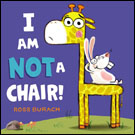
|
I Am Not a Chair
By Ross Burach
Giraffe is new to the jungle and on his very first day, he is mistaken for a chair. Oh dear. What to do? Since they can’t see the difference, Giraffe will have to show them by building a real chair. Which happens to look quite a bit like him. Suddenly, the most intelligent (ha!) species comes along and captures a brand new chair for his house. Giraffe sneaks out in the middle of the night only to be found and sat upon by the king of the jungle who is going to eat the next animal he sees. Hilarity ensues for your preschool audience. Illustrations were created with pencil and acrylic paints, then colored digitally. Recommended for ages 4 to 7.
—Tracy Gallagher, MLIS, Collection Development
|
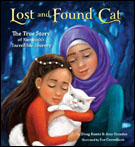
|
Lost and Found Cat: The True Story of Kunkush’s Incredible Journe
by Doug Kuntz and Amy Shrodes, with illustrations by Sue Cornelison
Based on real events, Lost and Found Cat tells the gripping story of a family’s escape from Iraq. Sura paid smugglers to get her, her five children, and their beloved white cat Kunkush out of the country. It was in Greece, just one of the many stops on their weeks-long relocation, that Kunkush got out of his carrier and disappeared. The family searched for as long as they could but had to move on to their final destination of Norway. Amy Shrodes, a volunteer and co-author of the book, saw the cat, filthy and hungry, and took him home, suspecting this was the lost cat of the Iraqi family she worked with a while back. A social media campaign was started to reunite Kunkush with Sura and the kids, and eventually word reached the family. Confirmation was made via Skype and Doug Kuntz, a photographer and co-author, flew the cat to Norway for a joyful reunion! Four pages of color photographs, a note from the authors, and a map of the journey make up the back matter. Readers can see a video, including the tears-of-joy reunion, on The Guardian’s YouTube channel (have tissues handy). Cornelison’s illustrations are soft and sweet and assure the reader that Kunkush won’t be apart from his family for long! Recommended for ages 4 to 7.
—Becky Walton, MLIS, Collection Development
|
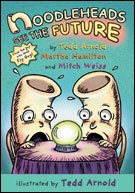
|
Noodleheads See the Future
by Tedd Arnold, Martha Hamilton, and Mitch Weiss
The Noodleheads are back and they can see the future! Actually, no, they can’t; that’s the problem. Mac and Mac just want to be helpful and bring their mother firewood for the oven so she can bake them a cake. They LOVE cake! But Meatball tricks the gullible pair into trading the wood for magic acorns which, when thrown in the ground, will grow firewood. Of course, they dig up the whole yard trying to grow it. Mom is delighted, can plant seeds for her garden, and bakes them a cake. Funny and cute, this graphic novel is recommended for ages 5 to 7.
—Jenny McCluskey, MSIS, Collection Development
|
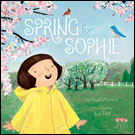
|
Spring for Sophie
by Yael Werber
Adorable Sophie in her red winter coat is anxious for spring to arrive and often asks, “When will spring be here?” much like the question, “Are we there yet?” Mom and dad help out by giving Sophie clues to observe hinting that spring is on its way. Sophie’s first signs are hearing chickadees chirping in nearby trees along with her boots beginning to sink into the snow instead of sliding. One day she notices flower shoots peeking up through the ground, but it isn’t until the day she smells rain in the air and tastes the raindrops on her tongue does she know that spring has finally arrived! Illustrator Jen Hill’s skeleton bare trees surrounded by mounds of snow are beautifully sketched along with the barn-red house and stone chimney exhibiting a cozy wintry-aura. Preschool and primary teachers will want to include this title with their units on seasons and the five senses. Recommended for ages 5 to 8.
—Jeanne Martin, M.Ed., Collection Development
|
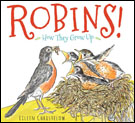
|
Robins! How They Grow Up
by Eileen Christelow
Christelow is a master of all as she both authors and illustrates this spring-themed narrative of a robin’s life cycle. Using large comic-type panels, Christelow illustrates authentically-colored images of robins hatching from eggs to flitting on their first flight. Readers will explore details about the robin’s migration, nest-building materials, food sources, protection, and its predators. I was impressed with the apprehensible illustrations introducing the concept of food chains with a hawk swooping and carrying off a baby robin with the explanation that she must feed her very own young also. Informative supplementary back matter includes a glossary, a question and answer format pertaining to robins and the author’s note revealing how her idea originated. This nonfiction title will pair nicely with the fiction title reviewed this month of Spring for Sophie. Recommended for ages 6 to 9.
—Jeanne Martin, M.Ed., Collection Development
|
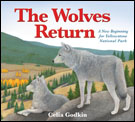
|
The Wolves Return: A New Beginning for Yellowstone National Park
written and illustrated by Celia Godkin
The last sentence of The Wolves Return perfectly sums up the message of this lovely nonfiction picture book: “Who would have thought that the return of a few wolves could have benefitted so many other animals?” Godkin succinctly outlines the species that have enjoyed success as a result of the return of the wolf to Yellowstone: the wolves keep the elk population in check -> more tree seedlings and berry bushes grow -> birds and bears now have food and shelter and beavers have trees to build dams-> dammed water creates ponds -> ponds harbor fish and insects that feed herons, otters, and osprey -> and so on. Young readers will enjoy seeing all the animals and plants that now flourish as a result of one change in an ecosystem. Godkin’s illustrations, created with pencil crayon and watercolor, are all two-page spreads and just beautiful. Recommended for ages 5 to 8. Combine this with When the Wolves Returned: Restoring Nature's Balance in Yellowstone by Dorothy Hinshaw Patent and The Wolves Are Back by Jean Craighead George to plant seeds for future ecosystem advocates!
—Becky Walton, MLIS, Collection Development
|
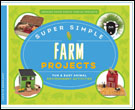
|
Super Simple Farm Projects: Fun & Easy Animal Environment Activities
by Carolyn Bernhardt
Abdo’s Awesome Super Simple Habitat Projects series uses projects and crafts to deliver fun hands-on habitat education! Each title in the series provides an introductory note to adult helpers regarding safety and explanation of symbols that will be used throughout to indicate when extra care or supervision is needed. There’s also information about the habitat and a photo guide for all materials used in the projects. End materials include conclusion, comprehension quiz, and glossary. In Super Simple Farm Projects, readers learn about the farm-to-table process and the food chain of a farm habitat. The projects are: Barn Owl Display, Grassy Stocking Sheep, Sloppy Crops Compost, Cow Hug Machine (based on Temple Grandin’s invention to calm cattle), Mini Pig Pen, and Cozy Chicken Coop. Each step is color photo-illustrated. Other titles in this cute set are Super Simple Backyard Projects, Super Simple Grassland Projects, Super Simple Ocean Projects, Super Simple Rain Forest Projects, and Super Simple Wetland Projects. Recommended for ages 6 to 9.
—Becky Walton, MLIS, Collection Development
|
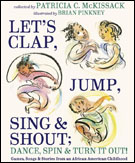
|
Let's Clap, Jump, Sing & Shout; Dance, Spin & Turn It Out!: Games, Songs, and Stories from an African American Childhood
by Patricia C. McKissack and illustrated by Brian Pinkney
Growing up, there are quite a few things I remember that made childhood so memorable – Sunday dinners at grandma’s, being the baby grandchild and reaping those benefits, singing in the children’s choir (at both my own [Baptist] church and my grandma’s [CME] church), and playing games with my friends on the playground and in the neighborhood. Some of my favorites were “Patty Cake,” “Itsy Bitsy Spider,” “Miss Sally Walker,” “Rockin’ Robin,” “Miss Mary Mack,” and “Eenie Meenie Miney Mo,” to name a few. When I was first handed Let’s Clap, Jump, Sing & Shout; Dance, Spin & Turn It Out, I wasn’t too sure of what I’d find, but I was excited to see what activities would be written inside. I’m happy to report it took me on a trip down memory lane and all the things you experience #GrowingUpBlack. McKissack does a wonderful job pulling in the African songs, folklore, poems, and history into this book. If you’re looking for a book that showcases the many different layers and cultures intertwined in the African-American experience, this one is it. It’ll be a great way for adults to have fun with kids while also teaching them about their ancestors and inspiring them to embrace their own individuality. Pinkney’s illustrations are just darling and well-suited for the fun tone of the book. Recommended for all ages.
—Ashley White, Digital Marketing Coordinator
|
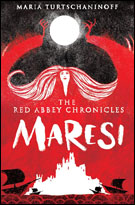
|
Maresi
by Maria Turtschaninoff
Debut author (at least, in the US) Turtschaninoff gives us a fantasy with such strong themes of womanly power, that all nascent young feminists will be inspired by her narrative. The title character is a novice in the island-bound Red Abbey where no man is allowed to set foot—enforced by the difficult sea passage and the Sisters’ feminine magic. It serves as a sanctuary from abusive and controlling men, taking in girls from distant lands in need of safety. Maresi is a certified bookworm who spends every free moment away from chores and prayer in the Knowledge House under the supervision of Sister O (read: Librarian) cloistered with her precious tomes. Nothing seems to upset this idyllic life until a new novice comes to the island, with her father chasing to get back “what is his.” What follows is anything but idyllic as the men from the ship rape and pillage the Abbey. The Sisters do fight back by invoking all the faces of the Great Mother: the Maiden, Mother & finally Crone, whom Maresi herself releases and the pirates suffer a terrible fate at her withered hands. Having seen and learned so much at the Abbey, Maresi is now inspired to leave her books for the wider world to pass on the knowledge she has gained. While women do triumph, sensitive readers may be upset by the stark (although not graphic) portrayal of the abuse suffered at the hands of men. This first volume in a planned trilogy is recommended for ages 14 and up.
—Jill Barton, MLIS, Collection Development
|
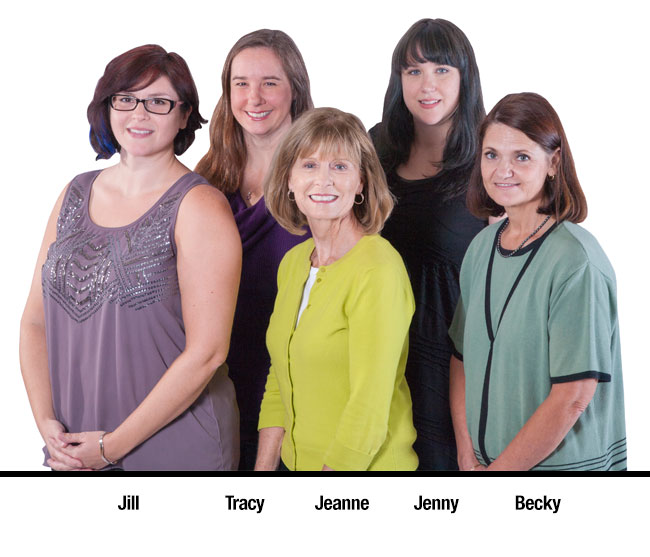
|
|



